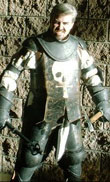|
|
This topic comprises 2 pages: 1 2
|
|
Author
|
Topic: Poor Projection Standards in L.A.
|
|
|
|
|
|
|
|
|
Paul Linfesty
Phenomenal Film Handler

Posts: 1383
From: Bakersfield, CA, USA
Registered: Nov 1999
|
 posted 11-03-2002 10:51 AM
posted 11-03-2002 10:51 AM




Ok. to fill in the blanks:"I cannot understand why most theaters pay no attention to the projection of their films. I see at least three shows a week. At "The Godfather" in Westwood, the screen blacked out for two minutes at a crucial point while the sound continued. At "The Hospital" at the El Rey the picture started without sound and continued for two minutes that way. Throughout the rest of the film, one projector was consistently out of focus and the operator never bothered to check. At Gruman's Chinese, the Egyptian and the Hollywood Pacific, large portions of the films were out of focus, and in Westwood one could not even read the subtitles of "Without Apparent Motive." Managers and ushers walk through fiddling around with thermostats and preparing sales of concessions, and when queried inevitably blame the print condition and not the projectionist. The latter watches TV and laughs in one's face when one tries to object. New theaters spring up with the ultimate in exterior comforts and conveniences yet nobody bothers with the most important item - that which brings the audience in the first place - the proper presentation of the picture." This letter appeared in April, 1972. The point? Much is said about sloppy operators today as opposed to the good old days, but this demonstrates that these problems have always existed (and in top first-run screens by (presumably) union operators using (presumably) changeover projection systems in single screens.
| IP: Logged
|
|
|
|
|
|
|
|
|
|
Steve Guttag
We forgot the crackers Gromit!!!

Posts: 12814
From: Annapolis, MD
Registered: Dec 1999
|
 posted 11-05-2002 08:27 AM
posted 11-05-2002 08:27 AM




Its not the filmstocks, Brad, it is the film makers! It is the story tellers. The quality of the show was better. And looking at such films a LOA...why can't a modern film look that good? Why cant a modern film have panned dialoge? I claim that the film makers of yesteryear did more with what they had. Come on...do you think Super-35 would have had a chance back then? The biggest improvement I've seen in the modern filming style is in the special effects department...the old effects are hokey. Also the surround channel I find much more suited in modern films and well implemented. Steve ------------------
"Old projectionists never die, they just changeover!"
| IP: Logged
|
|
|
|
|
|
John Pytlak
Film God

Posts: 9987
From: Rochester, NY 14650-1922
Registered: Jan 2000
|
 posted 11-05-2002 10:48 AM
posted 11-05-2002 10:48 AM





I agree with Steve --- precise localization of the sound to the source really helps. Going a step further, actually recording multichannel sound and playing it back with proper localization and phase relationships gives a totally realistic sound, unheard in theatres today except for Cinerama and some special venue presentations. When I saw "Seven Wonders of the World" presented by John Harvey in original 3-strip Cinerama at the New Neon Theatre in Dayton, I was amazed at the sound "presence", despite the almost 50-year old recording and playback technology. During the "Indian Wedding Parade" sequence, you could close your eyes and still feel you were in the middle of that crowded Indian street as the parade passed by on both sides of you. Amazing. 
------------------
John P. Pytlak, Senior Technical Specialist
Worldwide Technical Services, Entertainment Imaging
Research Labs, Building 69, Room 7525A
Rochester, New York, 14650-1922 USA
Tel: +1 585 477 5325 Cell: +1 585 781 4036 Fax: +1 585 722 7243
e-mail: john.pytlak@kodak.com
Web site: http://www.kodak.com/go/motion
| IP: Logged
|
|
Lionel Fouillen
Expert Film Handler

Posts: 230
From: Belgium
Registered: Nov 2002
|
 posted 11-05-2002 11:01 AM
posted 11-05-2002 11:01 AM




I think that what lacks in many films today is a certain amount of splendor and professionalism in the making.Recently I watched the DVD (in full 2.55 aspect ratio) of "How to marry a millionaire" with Marylin Monroe. I had never seen this film before and was amazed... First, the Fox logo followed by a prologue showing the Fox fanfare conducted by Alfred Newman playing the main musical theme to the film, then the opening credits, then the story itself. Look at how it was beautifully photographed. The photo composition is polished up. And that's CinemaScope! Let's watch it in pan&scan and see if we still understand the film. There are many shots where the camera is static or slightly panning, showing 2 or 3 of the main characters talking to each other. I made a test and put my left and right speakers far away from the center speaker and I could clearly hear dialogs coming from "between" speakers in my living room. I can imagine the precise stereo effects obtained in a theatre, showing all the benefits of true discrete stereo mixing. Not to mention the talent of the actors and actresses who were used to act in longer shots, with more elements or people dealing with each other within the camera capture angle. BTW, do you remember the opening sequence of The Player by Robert Altman? Just brilliant direction... Today, dialog is kept in the center mainly because the damn' matrixed Dolby Stereo doesn't allow you to pan sounds across channels. And you wonder if the way films are shot and cut is serving poor acting where it's easier to remake a shot when 2 characters talking to each other are filmed with 2 cameras, 1 pointing at each actor's face... Have them play on stage before an audience, for 2 hours without the possibility to make mistakes and start again, and then I'll accept to call them actors. As for the filmmakers, why do they use this method of choosing one aspect ratio in the making, that will allow them to crop either the sides or bottom/top of the picture depending on if the release print is intended for theatre or TV/video (examples: Dick Tracy, Terminator 2). Why can't they choose one ratio, stick to it and compose the picture by artistically exploiting the specs of the chosen format... But I also agree with Brad about some things. Why refuse technological progress when it allows you to improve the making or the projection. The question is: does progress always improve things?
| IP: Logged
|
|
|
|
|
|
All times are Central (GMT -6:00)
|
This topic comprises 2 pages: 1 2
|
Powered by Infopop Corporation
UBB.classicTM
6.3.1.2
The Film-Tech Forums are designed for various members related to the cinema industry to express their opinions, viewpoints and testimonials on various products, services and events based upon speculation, personal knowledge and factual information through use, therefore all views represented here allow no liability upon the publishers of this web site and the owners of said views assume no liability for any ill will resulting from these postings. The posts made here are for educational as well as entertainment purposes and as such anyone viewing this portion of the website must accept these views as statements of the author of that opinion
and agrees to release the authors from any and all liability.
|

 Home
Home
 Products
Products
 Store
Store
 Forum
Forum
 Warehouse
Warehouse
 Contact Us
Contact Us




 Printer-friendly view of this topic
Printer-friendly view of this topic









 I just cannot understand how theatres cannot run top notch shows. Especially in L.A. Being that close to Hollywood, I would be scared silly of I had any glitches in my booth. I would not want to risk being embarassed. I am that way now and always have been that way as well.
I just cannot understand how theatres cannot run top notch shows. Especially in L.A. Being that close to Hollywood, I would be scared silly of I had any glitches in my booth. I would not want to risk being embarassed. I am that way now and always have been that way as well. 











